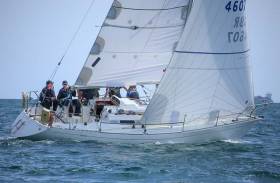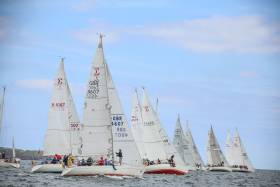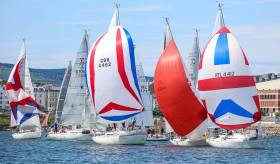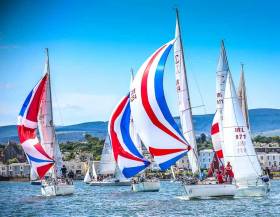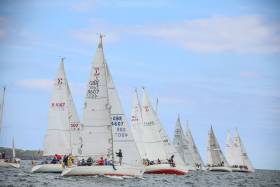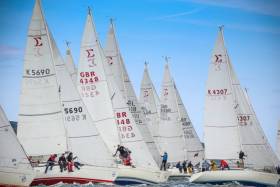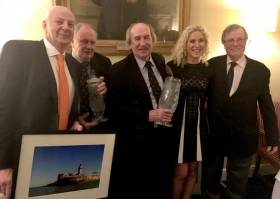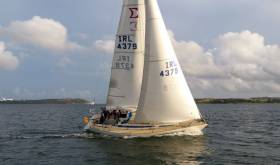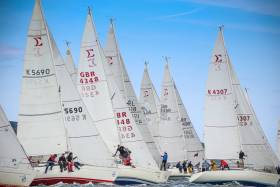Displaying items by tag: Sigma 33
Leaky Roof II Leads Sigma 33 Nationals at Dun Laoghaire
Scottish visitor Leaky Roof II skippered by Alan Harper of Cove Sailing Club leads the Sigma 33 Class and Irish Championship 2018 after eight races sailed at the Royal St. George Yacht Club in Dun Laoghaire.
Visiting boats continue to dominate the overall placings but there was a race win in race five for Royal St. George's Gwilli Two skippered by Paddy Maguire.
It's a result that puts the former Irish Sailing President as top host boat in tenth place in the 22-boat fleet. Racing continues tomorrow.
Results are provisional click here
Scottish visitor Sigmatic skippered by Donald McClaren of Helensburgh SC leads the Sigma 33 Class and Irish Championship 2018 at the Royal St. George Yacht Club in Dun Laoghaire.
Visiting boats take the top ten places after three races sailed in the record 22-boat fleet with the top Dublin Bay boat being Rupert (Dick Lovegrove) in 11th place.
Results are provisional
1st GBR 4270 Sigmatic Donald McClaren Helensburgh SC
2nd GBR 4462 Excelle John Fox Flushing SC
3rd IRL 4412 Miss Behavin Grant Simpson Helensburgh SC
Full results click here
Entries closed yesterday for the Sigma 33 Class UK and Irish Championships 2018 on Dublin Bay this weekend.
The Royal St. George Yacht Club organisers have confirmed 23 entries, being 161 competitors from five countries.
Racing takes place from Friday to Sunday with ten races scheduled over the three days, all under the watchful eye of International Race Officer David Lovegrove.
"The Royal St. George Yacht Club organisers have confirmed 23 entries, being 161 competitors from five countries"
There are 15 visiting boats from 13 visiting clubs and eight local boats and in looking at the quality of the visitors it is clear that many of them could achieve a podium finish. It would certainly be difficult to pick a winner. It all adds up to a competitive weekend on the water Sigmas.
There'll be a full house for the Championship dinner in the Royal St George Yacht Club on Saturday evening where the guest speaker is Tim Goodbody, a Sigma 33 champion, who needs no introduction to the fleet.
Download the Sigma 33 Sailing Instructions below
It is 34 years since the first Sigma 33 was sailed at the Royal St George Yacht Club but next month's Class Championships will be the first ever staging of the event by the Dun Laoghaire Club.
A 21–boat fleet that is drawn from five countries will contest the title.
In it's 39–years history, 364 boats in total were built. The Sigma 33 has proved to be a popular club, regatta and offshore boat well capable of making distance passages to regattas and events.
The Sigma 33 also has participated in offshore and overnight racing and has proved to be a safe family cruising boat with the option of class racing both in the UK and Ireland.
In Dun Laoghaire in 1984, “Eggemoggin“ was the first Sigma 33, sailed by Adrian Lee and crew, to sail from the RStGYC. It was later followed by “Tahoe” sailed by the late John Marks. Dublin Bay sailor Gary Mathews who sailed on “Eggemoggin” is still sailing today on “Rupert” sailed by club mates Dick & Philip Lovegrove.
The class went on to become one of the biggest one–design cruiser racers in Dublin Bay during the Noughties.
Now, 34 years later, The George is hosting, for the first time, the Sigma 33 Class Championships from 22nd – 24th June 2018 and looks forward to assembling the fleet at the club pontoon, according to class captain Paddy Maguire.
Sigma 33 Fleet Reaches 20 Boats for Royal St. George Championships; Early Bird Entry Deadline Extended
The Class Captain of the Sigma 33 East Coast Association is reporting a bumper entry of 20 'Early Bird' entries received from 14 different clubs for June's Dublin Bay Chmpionships at the Royal St. George Yacht Club.
'The entries to date reflect strong interest in Sigma 33 sailing', class chief Paddy Maguire told Afloat.ie.
As Afloat.ie previously reported, a fleet of 25 boats – and possibly more now – is expected to gather from Northern Ireland, Scotland, England and Wales.
This weekend, the regatta's Notice of Race was amended in order to extend the date for receipt of Early Bird Entries to next Wednesday (March 21st).
The class and Irish Championships are being held in the Royal St George Yacht Club from 22nd – 24 June 2018.
Download the NOR here
Sigma 33 sailors are making their sailing plans in good time for 2018 with 15 entries from 11 different clubs received for the class and Irish Championships being held in the Royal St George Yacht Club from 22nd – 24 June 2018.
As Afloat.ie previously reported, a fleet of 25 boats is expected to gather from Northern Ireland, Scotland, England and Wales.
The class boasted a fleet of 19 for last year's Dun Laoghaire Regatta, producing one of the biggest one design keelboat events in the 2017 fleet.
The early bird entry for June's event closes on 17th March 2018 and all entries received on or before that date will be entered in a draw and the lucky winner will receive a refund of their entry.
Organisers have announced that the draw for the refund of the entry fee will take place in the Royal St George Yacht Club on Thursday 22nd March 2018 at 7.00 in the Trophy room.
Download the NOR here
2018 Sigma 33 OOD Class & Irish Championships For Royal St.George Yacht Club (Download Notice of Race Here)
The Sigma 33 class is 39–years–old this year and this June the Royal St. George Yacht Club will host the Class and Irish Championship, the first occasion the Dun Laoghaire Club has held these combined events.
Download the notice of race below.
'It's a great prospect for both the club, with all its experience of major events, and the class, which will be berthed on the clubs pontoons, making for a unique event', Class Captain Paddy Maguire told Afloat.ie
Despite the boats age, the class is very capable of drawing both the top sailors and fun sailors to its annual Championship in good numbers from June 22–24.
As Afloat.ie reported at the time here, Volvo Dun Laoghaire Regatta last year attracted 20 entries and similar entries are expected this June.
St.Patricks Day (17th March) will have an extra significance for Sigma 33 sailors next month as it is also the deadline for the closing of Early Bird entries at the discounted rate of €169.
All entries received will automatically be entered in a draw and one lucky entrant will have their entry fee refunded.
'It would be great to have a home town winner or a top 3 place which has not been possible in recent years since Tim Goodbody was a competitor', Maguire told Afloat.ie
Over 70 Sigma 33 sailors, friends and guests attended the Sigma 33 East Coast Association Annual Prize giving dinner at the Royal St George Yacht Club last night hosted by Dick Lovegrove, the classes senior Sigma 33 sailor.
Prizes were presented to the top three boats at the 2017 Irish Sigma 33 Championships.
- Squawk - Paul Prentice RUYC
- Gwili Two - Dermot Clarke & Paddy Maguire R ST. GYC
- Flyover - David Marchant & Others Waterford Harbour Sailing Club
Silver Fleet winner: “Leewin” Henry Leonard & Bobby Kerr RIYC
The Sigma 33 class prizes were as follows:
- Boss Trophy: Gwili Two Dermot Clarke & Paddy Maguire R St. G Y C
- The Michael O’Herlihy Trophy: Leewin Henry Leonard & Bobby Kerr RIYC
- Sigma 33 Class Trophy: Elandra Joe Conway RIYC
- The Coleman O'Sullivan Trophy: Paddy Maguire RStGYC
There was big success for Joe Conway in Elandra who was a class winner in ISORA in his first year.
 From left to right at the Sigma 33 Prizegiving were Bobby Kerr, Henry Leonard, Dermot Clarke, Paul Prentice and David Marchant
From left to right at the Sigma 33 Prizegiving were Bobby Kerr, Henry Leonard, Dermot Clarke, Paul Prentice and David Marchant
The Sigma 33 was one of the biggest one design cruiser fleet at last July's Volvo Dun Laoghaire Regtta with 19 entries.
The Dun Laoghaire Regatta series had 19 entries including nine from the home waters and ten visitors from Northern Ireland, Scotland, England, the Isle of Man and local boats from Arklow and Waterford. The nine race series was dominated the top six visiting boats. Most of them had competed at regattas in Tarbert and Helensburgh and benefited from the close racing at both events. It proved very difficult for local boats to break into the top six in any race.
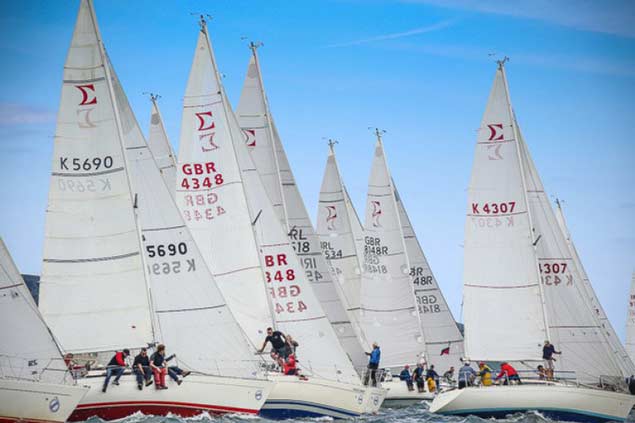 The Sigma 33 had 19 entries at last July's Volvo Dun Laoghaire Regtta
The Sigma 33 had 19 entries at last July's Volvo Dun Laoghaire Regtta
The long established Dublin Bay class merged with class two for local DBSC racing in 2017 but the class retains its one design status for special races such as its championships and last year's Dun Laoghaire Harbour Bicentennial Race Day.
Sigma 33 class attention now turns to 2018 season and the Sigma 33 Class Championships 22nd – 24 June 2018 on Dublin Bay.
What the Sigma 33 Means to Me
Hearing about the open morning on Sunday, the 24th of September at the Royal St.George YC in Dun Laoghaire where Sigma 33 Class Captain Paddy Maguire wants to raise more interest in Sigmas, brought back how I became interested in the Sigma, the design of David Thomas and whom I read about sailing the Sigma with his young grandson, which first attracted my attention to the boat. I bought a Sigma, have sailed her for 17 years and nowadays my 13-year-old grandson has become one of her regular helms and she has been crewed by his 11-year-old brother and their friends, often outnumbering the three adults on the crew…and winning races!
When I first set eyes on her I liked her looks – and still do…. She had a beautiful shape..Unfortunately, inside was different! She seemed to have been abandoned in a hurry and to have been pretty hard raced. I was to learn that racing commitment was not unusual amongst Sigma 33s.
Despite her internal appearance I bought her. She is now 33-years-old - first launched in 1984 and, after 17 years I still feel pleasure and joy when sailing her, even though she is now out of Class because, to the horror of some owners I changed her looks!
Listen to the Podcast to hear what I did and why - and how, despite the changes, this old Sigma is still capable of showing her stern to some more modern, newer and bigger boats and about my worst day with her, but which she and I survived.
Dublin has an active Sigma one-design fleet. In Cork Harbour, where I sail, there are half-a-dozen active Sigma racers, in Class 3 and Whitesail.
Isn’t what matters most – getting use out of your boat?
Good luck to the Sigma Class in Dublin and the open morning on Sunday, September 24 from 9.30 a.m. to 1 p.m. There’s an opportunity to sail one and there’s finger food afterwards….. If you’re interested … Email Class Captain Paddy Maguire on: [email protected]
Listen to the Podcast below
Are you Interested in Sailing or Buying a Sigma 33?
Are you Interested in Sailing or Buying a Sigma 33?
Experience a sail at our Open Morning on Sunday, 24th September 2017 at the Royal St. George Yacht Club
from 9.30–1.00 O’Clock
Followed by finger food in the Club afterwards
For more details call Paddy Maguire 087 2361916 or e- mail [email protected]
More details on the Sigma 33 class from the 2017 season below.
The Volvo Dun Laoghaire Regatta was for the Sigma 33 one design class the third major open Championship of 2017. The season stared in Tarbert, Scotland at the end of May, with the Scottish series with ten competitors and was won by “Mayrise” James Miller of Cove Sailing Club (CCC) with four wins from eight races.
The next event was in Helensburgh in Mid-June for the Class Championships which was won by “ Miss Behavin” Alan Lennox, Helensburgh Sailing Club. The 13–boat fleet completed eight of the ten planned races over the three days.
The Dun Laoghaire Regatta series had 19 entries including nine from the home waters and ten visitors from Northern Ireland, Scotland, England, the Isle of Man and local boats from Arklow and Waterford. The nine race series was dominated the top six visiting boats. Most of them had competed in Tarbert and Helensburgh and benefited from the close racing at both events. It proved very difficult for local boats to break into the top six in any race. The racing was very competitive with places changing on all legs. The Dun Laoghaire Regatta series was won by Alan Harper & Kristy Robertson in “ Mayraise” The Irish Championship were run in conjunction with the regatta and won by Paul Prentice in “ Squawk” from the Royal Ulster Yacht Club.
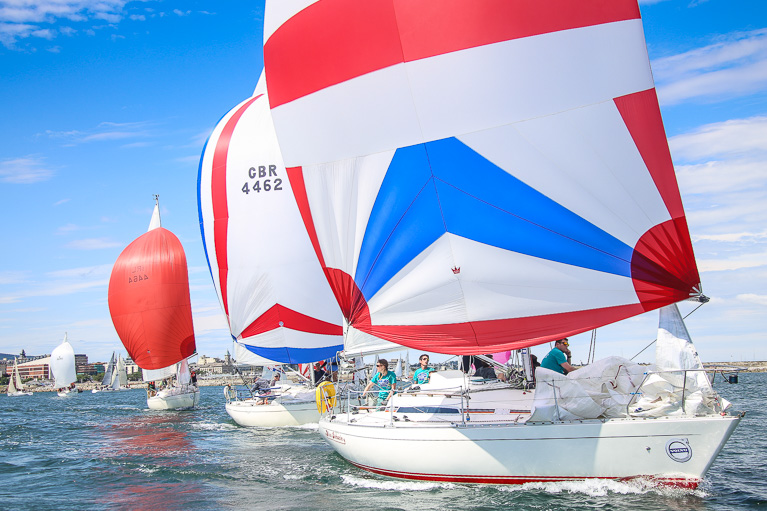 Visiting Sigma 33 crews to Dublin Bay in July visiting crews were made up of young and experienced sailors, both men and women. Photo: Afloat.ie
Visiting Sigma 33 crews to Dublin Bay in July visiting crews were made up of young and experienced sailors, both men and women. Photo: Afloat.ie
The Sigma 33’s were the biggest one design keelboat class at the regatta and this added to the more enjoyable competition for competitors. The visiting crews comprised young and experienced sailors, both men and women. It’s on occasions like that that you think of how good Tim Goodbody was in that he was regularly in the top three in such regattas.
It wasn’t all racing and on the Friday night 120 of the fleet held a bicentennial Dinner in The Royal Irish Yacht Club. Prizes were presented to the winners of the day’s racing “ Mayrise” Alan Harper and Kristy Robertson CCC and “Rupert” Richard and Philip Lovegrove of the RStGYC. Thanks to Dun Laoghaire Harbour Company, each boat was presented with a History of the Harbour.
The local fleet will recognise that they need to be more competitive as a fleet if they are to compete more successfully in this type of competitive regatta. There is a big incentive for the Class. In 2018, the Sigma 33 National Championships and Irish Championships will be held in Dun Laoghaire and 2019 is a Dun Laoghaire Regatta year. It is expected that similar entries to 2017 will compete each year. This also provides a great opportunity for young local sailors to acquire a Sigma 33 with a major event in local waters for each of the next two years and discover how successfully they could compete against the visitors and local sailors.
 The Sigma 33 Fleet will hold a 'Sigma 33 Morning' on Sunday 24th September 2017 at 9.30am in The Royal St. George in Dun Laoghaire
The Sigma 33 Fleet will hold a 'Sigma 33 Morning' on Sunday 24th September 2017 at 9.30am in The Royal St. George in Dun Laoghaire
As part of the recognition of the changes required to improve our competitiveness, the Sigma 33 Fleet will hold a 'Sigma 33 Morning' to enable anyone interested in buying or sailing on Sigma 33’s to sail on Sunday 24th September 2017 at 9.30am in The George. All are welcome to come down and to join us for finger food afterwards. If you wish to attend please confirm your attendance by contacting Sigma 33 Class Captain Paddy Maguire at [email protected]




























